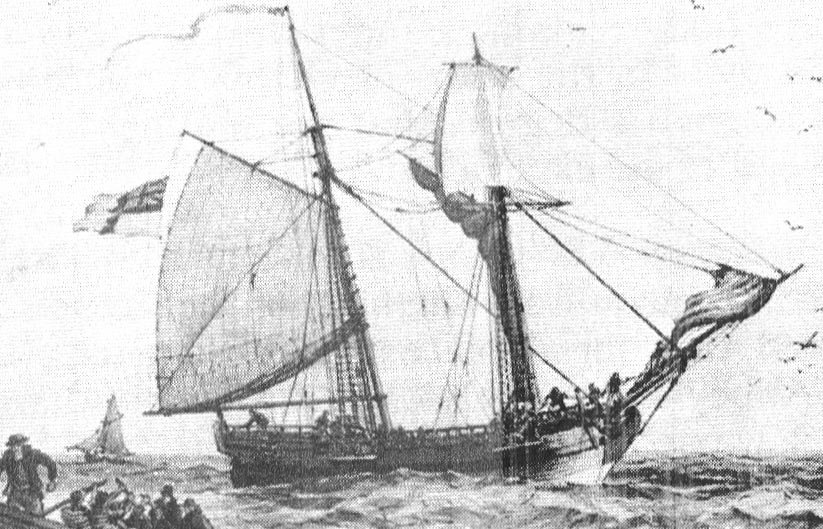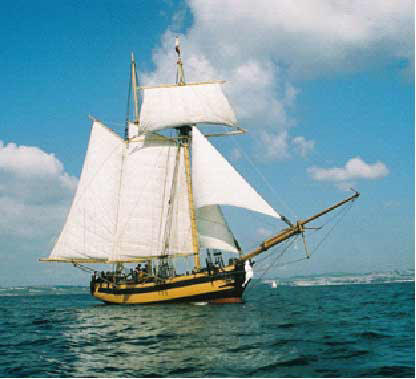Lieutenant John Richard Lapenotiere, Captain
This schooner was a fast dispatch vessel and was directed by Admiral Collingwood to carry the news of the victory - and of Nelson's death - to the Admiralty in London. She was fitted with 10 guns after being purchased by the Royal Navy in 1800 from Bermuda [1] . She served till she was wrecked in a storm off Cadiz.
Seven ships subsequently bore the same name in service of the Royal Navy. The last was an Algerine class minesweeper transferred to Ceylon (later called Sri Lanka) in 1959. One hundred and nine of this class were built for the Royal and Royal Canadian Navies 1942-44 for world War 2 service. They were armed with one 4" and four 20mm guns and displaced 850 tons, with a crew of 85. http://en.wikipedia.org/wiki/HMS_Pickle
In 1996, an exact replica of the ship was built by a Leningrad yard. The dimensions are:
- Feet Metres LOA (length overall) 96’6” 29.4m
- LOD (length over deck) 61’4” 18.7m
- Beam (width) 15’4” 4.6m
- Draught (deep) 7’4” 2.3m
- Displacement: 38 tons
We do not know the displacement of the original Pickle.

|
The schooner set off on the 26 October and took 9 days to reach Britain, enduring a gale off Cape Finisterre. The vessel was blown off course and Lapenotiere ordered that 4 carronades to be cast overboard to lighten the load. At 9.45am on November 4, the Pickle anchored in Falmouth Bay. By midday, Lapenotiere was on his way to London in a hired post-chaise coach, displaying a Union Flag and a tattered Tricolour on a broomstick as a flagpole. The normal journey took a week, but within 37 hours, after 19 horse changes, Lapenotiere arrived at the Admiralty at 1am on 6 November. He was shown through to the First Secretary of the Admiralty, Mr Marsden. Lord Barham, First Lord of the Admiralty was raised from his sleep to receive the news. The Prime Minister, William Pitt received the news at 3am and King George III and Queen Charlotte heard at 7am. As the news was being broadcast across the city with saluting guns from the Tower of London, the news was also received by an hysterical Emma Hamilton. Lapenotiere was later given an audience with the King and Queen and was presented with a silver cruet, the first thing the King could find to hand. He was also promoted to Commander. Direct quote from http://www.hmspickle.org.uk/default.asp?data=1 |
It is said that the new Commander also received Pounds 500. http://www.bbc.co.uk/cornwall/content/articles/2005/07/04/coast05_walk_stage6_feature.shtml
|
Bermuda-built schooners had unique advantages. Their construction from Bermuda cedar ensured they were durable and resistant to shipworm. Cedar was plentiful then and unlike oak, from which many of the larger ships were made in the United Kingdom, did not require seasoning. Yet another such Bermuda-built schooner established her own special claim to fame in 1805. She was the small warship HMS Pickle of the Royal Navy. HMS Pickle was the fastest and one of the hardiest ships in the Royal Navy. Direct quote from http://www.bermuda-online.org/rnd.htm |

The modern Pickle, which is a replica of the 1st of the name.
PHOTOGRAPH FROM http://www.classic-sailing.co.uk/join_hms_pickle.htm
_____________________________________________________________
[1] One source gives Pickle only 4 guns.